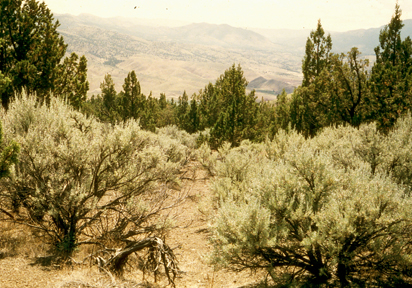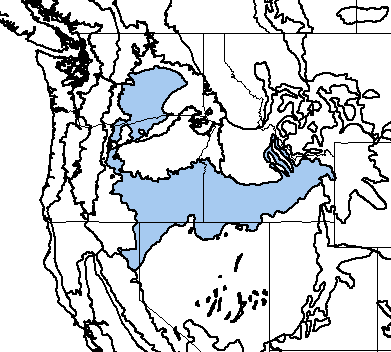
eastern Oregon (c) 2005 Carol J. Baskauf
Bioimages home (click on an image to enlarge)
view
this page in its intended navigation context
Snake-Columbia shrub steppe (WWF
ecoregion NA1309)

eastern Oregon
(c) 2005 Carol J. Baskauf

Source of bioregions data:
Olson, D. M. and
E. Dinerstein. The Global 200: Priority ecoregions for global conservation. (PDF
file) Annals of the Missouri Botanical Garden 89:125-126.
Distinctiveness (1=highest,4=lowest): 3 (bioregionally
outstanding)
Sagebrush dominates the vegetation. Isolated mountain ranges contain fir
and aspen species. *
Conservation Status (1=most endangered, 5=most
intact): 2 (endangered)
Overgrazing, fire suppression, and invasive grasses are the major threats to the
ecoregion. Conversion to agriculture creates fragmentation.*
 | Artemisia tridentata (big sagebrush) | ||
 | Artemisia tripartita (threetip sagebrush) | ||
 |
Agropyron spicatum or
Pseudoroegneria spicata ssp. spicata (bluebunch wheatgrass) |
 | Pseudotsuga menziesii | (Douglas fir) |
 | Abies lasiocarpa | (subalpine fir) |
 | Populus tremuloides | (quaking aspen) |
Associated habitats
arid steppe, Klickitat Co., Washington



(c) 2005 Steven J.
Baskauf hires
hires
hires
riparian area, Columbia River near The Dalles, Washington


(c) 2005 Steven J.
Baskauf hires
hires
savanna, Lassen Co., California

(c)
2005 James H.
Bassett hires
* Ricketts, T.H., E. Dinerstein, D.M. Olson, C.J. Loucks, et al. (1999) Terrestrial Ecoregions of North America: A Conservation Assessment. World Wildlife Fund - United States and Canada. Island Press, Washington, D.C. pp. 337-340.